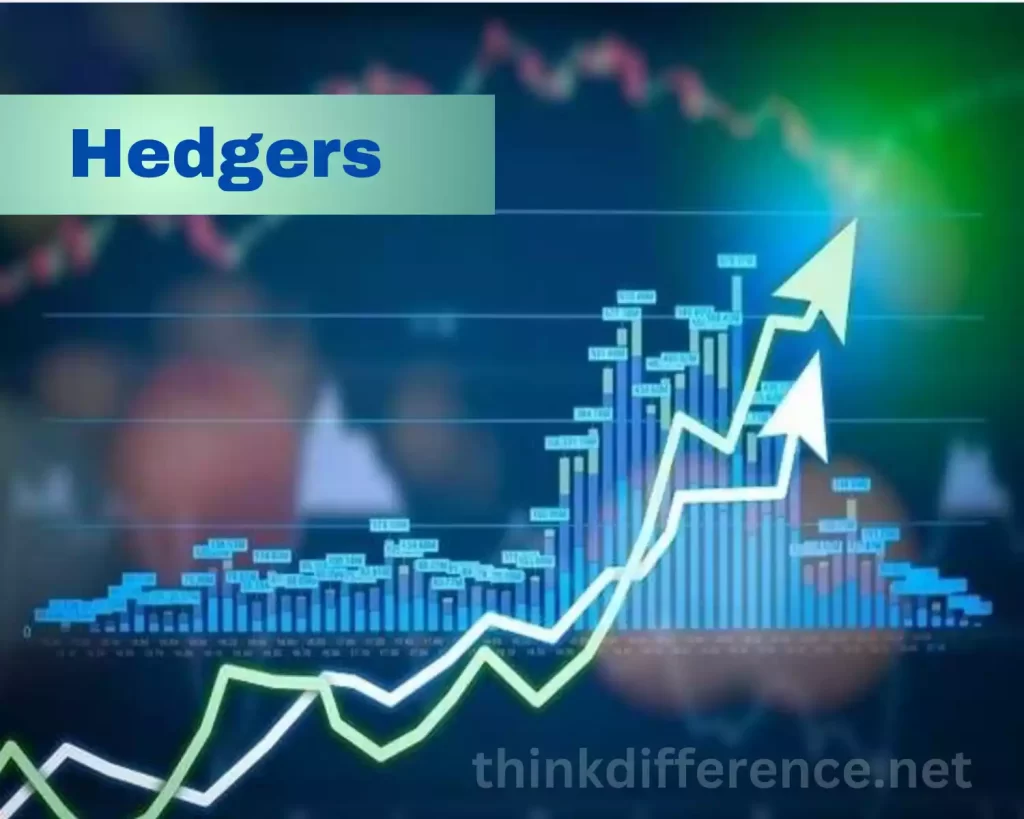Definition of Hedgers and Speculators
Hedgers can be individuals, businesses, or investors who use hedging strategies to protect themselves against adverse price movements on the financial or commodity market. Hedging involves taking positions to lessen or eliminate price fluctuations. Its primary aim should be risk mitigation rather than making money off market fluctuations. Hedgers typically are real investors in whatever asset they’re hedging and use it as a risk management strategy to secure their financial future and predict cash flow or asset values in future periods.

Speculators are individuals or companies who trade financial markets or commodities to capitalize on any price fluctuations to profit. While hedgers are directly exposed to assets being traded, speculators typically do not possess any direct interests in them. Speculators take positions based on what they expect will happen in the future, hoping to profit by purchasing low and selling high, or vice versa. Although they tend to focus more on short-term gains than hedgers do, speculators are willing to assume more risks and are therefore typically considered “speculators”.
To maximize returns and ensure maximum profitability, traders often employ various trading techniques like leverage trading and speculation products. Speculators play an essential role in providing liquidity in markets by helping determine prices; they may also increase volatility in these same markets by acting as market speculators themselves and presenting risks to other participants.
Understanding the difference between Hedgers and Speculators is important
Understanding the difference between hedgers and speculators is important for several reasons:
- Risk Management: Hedgers use hedging strategies to minimize or mitigate price fluctuations that threaten their financial position and position themselves for security and stability. Learning what distinguishes hedging from speculation will assist businesses and individuals manage risks better while safeguarding assets.
- Investment decision-making: Accurate investment decisions depend on distinguishing between hedging and speculation. Investors must carefully assess their risk tolerance and investment goals when choosing whether a hedging strategy or speculation will best fit with them and their goals, to manage their portfolio accordingly. Understanding this difference helps investors to make educated choices.
- Market stability: Each plays an essential part in financial markets. Hedgers manage price volatility through the use of hedging tools; while speculators add liquidity and price discovery. By understanding their respective roles in market regulation policies that aim to promote both stability and efficiency.
- Pricing Dynamics: Hedging, speculation and other factors can have an enormous effect on asset prices. Hedging can alter supply and demand dynamics to have short-term impacts on prices; through buying/selling activities speculators can influence market trends and price movements; understanding hedgers/speculators can assist market participants, analysts, and researchers in understanding pricing patterns as well as factors driving them.
- Speculators and Investors for Risk Evaluation: Banks and insurance companies need to accurately assess customer risks; by differentiating between hedgers and speculators more precisely risk exposure can be assessed, leading to more precise risk evaluation and management strategies being put in place.
Understanding the distinctions between hedgers (speculators) and speculators will enable individuals, businesses, and regulators to effectively manage risk, make sound investment decisions, preserve market stability, and interpret pricing dynamics.
Hedgers
Hedgers can be defined as individuals, or businesses who utilize hedging strategies to hedge against adverse price movements in the financial markets. Hedging involves taking positions to minimize or eliminate price fluctuations’ effect and reduce or eliminate its effect – with its primary goal being risk mitigation rather than profiteering from market fluctuations.

Hedgers tend to be real investors in whatever asset they’re protecting with this tool for risk management; their goal is securing their financial standing by anticipating cash flow or asset value fluctuations and forecasting cash flows or asset values in advance.
Hedging can be utilized in various industries and sectors, including:
- Farming: Farmers who want to secure minimum values and limit losses should enter futures contracts or options agreements for crops and livestock they grow, to withstand sudden price movements that might otherwise impact them negatively. They can thus ensure maximum value from their products at minimum costs.
- Importers and Exporters: Businesses involved in international trading can utilize hedging strategies to manage currency exchange rate risks. To hedge against fluctuations, import and export companies can enter forward contracts or currency options to ensure steady costs during import or export transactions.
- Manufacturing: Futures contracts and derivatives offer manufacturers an effective tool to offset raw material cost fluctuations by locking in prices in advance, mitigating production cost volatility while maintaining profit and keeping costs under control.
Hedgers employ various strategies and financial instruments to hedge their risks, including:
- Forward Contracts: Forward contracts are agreements between two parties to purchase or sell specific assets at future dates at fixed prices, providing hedgers the means of locking-in prices against fluctuation in asset markets.
- Options Contracts: An option provides its buyer with the ability to buy or sell specific assets within a set period at a set price, offering hedgers protection against adverse price movements while maintaining flexibility to take advantage of favorable price changes and capitalize.
Hedging may not eliminate risk, but it can lessen it significantly. Hedging strategies may be complex and expensive to execute correctly; market movements may not reflect expectations from hedgers either.
Speculators
Speculators are individuals or companies who trade financial markets or commodities to profit from price changes, unlike hedgers who directly expose assets being traded. Speculators take positions based on what they predict might happen in the future, hoping to profit by buying low and selling high versa. They tend to focus more on short-term gains while taking greater risks compared to hedgers and often employ various trading strategies.

Including leverage techniques or derivative financial instruments to increase returns and maximize potential returns, Maximize potential returns using various trading techniques or derivative instruments like swaps or swaps to increase potential returns from market volatility and price changes in assets being traded by hedgers and hedgers respectively.
Speculators can be found in various markets, including:
- Day traders: Day traders engage in short-term trading strategies by opening and closing positions within one trading session. Their decisions often revolve around technical analysis, short-term patterns, or market trends to maximize intraday price movements for maximum gain.
- Commodity traders: Commodity traders are market Speculators who buy and sell commodities such as gold, oil, or agricultural products to profit from price movements. ETFs (Exchange Traded Funds), Futures Contracts, or Options Contracts provide exposure to commodity markets.
Speculators employ numerous strategies and techniques in their trades:
- Buying and Selling Assets: Speculators purchase or sell assets like commodities, stocks, currencies, and other valuables with the hope that their value will either increase over time when an investment becomes worthless. They might buy one hoping its price rises over time while they sell another to take advantage of falling asset values.
- Leveraging Techniques: Speculators utilize leverage in trading positions by borrowing money to increase trading positions through borrowing; by borrowing they increase both potential profit (and loss) by borrowing against margin contracts, futures contracts, or options instruments which use leveraged trading techniques.
Their trading activities help increase market liquidity by narrowing bid-ask differences and contributing to price discovery, while excessive speculation or irresponsible trading practices could create market instability posing potential threats to other participants.
Investors, regulators, and market participants need to gain an understanding of speculators’ roles and strategies so they can manage risk, evaluate market dynamics and make sound investment decisions.
Differences Between Hedgers and Speculators
The differences between hedgers and speculators can be summarized in several key aspects:
1. Motivation:
- Hedgers: These practitioners employ various hedging strategies to mitigate and manage risks, protecting existing assets as well as future transactions against adverse price changes. Hedgers focus more on risk mitigation rather than making speculative gains through speculation.
- Speculators: Speculators are defined as those who participate in markets for profit alone and position themselves based on expected future price movements; hoping to purchase low and sell high, or vice versa; potential financial gain is what motivates these traders rather than risk management strategies.
2. Time Horizon:
- Hedgers: Hedgers are individuals with long-term goals in mind who wish to maintain their financial positions over time while anticipating future cash flows or asset values. Hedging strategies may help reduce long-term exposure risk.
- Speculators: Speculators tend to focus on short-term gains from price fluctuations to generate money quickly and frequently through trades held for shorter timeframes ranging from minutes up to several weeks.
3. Risk Tolerance:
- Hedgers: Hedgers tend to be less risk-averse. Hedging can help them protect against potential losses and lessen price fluctuation’s effects; for this reason, these investors put greater weight on risk reduction and stability than on higher returns.
- Speculators: Speculators tend to take more risks in pursuit of profits; in their pursuit, they’re willing to accept higher levels of risk through leveraged positions that expose them to greater market fluctuations and instability.
4. Impact on Markets:
- Hedgers: Hedgers play an invaluable role in market stability. Utilizing various hedging instruments, hedgers utilize them to reduce volatility and manage risks more effectively – they’re incentivized by real exposures they hold, helping keep markets stable.
- Speculators: Speculators play an integral part in creating market volatility. Their short-term expectations of price can lead to dramatic fluctuations that amplify. Although speculators increase liquidity in the market, they can also cause price instability.
5. Role in Price Discovery:
- Hedgers: Hedgers don’t directly participate in the discovery of prices; rather, their transactions focus on risk management rather than providing any new insights or influencing market prices directly.
- Speculators: Speculators play an integral part in discovering prices. Trading activities based on future price expectations can influence supply and demand dynamics that ultimately shape market pricing structures.
Hedgers (risk managers) and speculators (price discoverers) play essential roles in financial markets. Hedgers serve to stabilize markets by managing risks effectively while speculators help create liquidity on the market and set prices; coexistence among hedgers, speculators, and market participants ensures smooth market operations.
Similarities Between Hedgers and Speculators
There are similarities and differences between hedgers, speculators, and investors:
- Financial Market Participation: Hedgers are active participants in financial markets who actively purchase and sell assets such as stocks, commodities, and bonds to meet their goals.
- Profit is the ultimate aim: Both hedgers (who focus more heavily on risk management) and speculators (who engage more directly in market speculation) strive for financial gain by way of profits earned in markets. Hedgers seek to protect assets against possible losses while speculators engage more directly by looking for financial gains through price fluctuations.
- Use of various trading instruments: Hedgers and speculators both utilize various trading instruments in their strategies, from futures contracts and derivatives such as options or swaps to manage exposure to price changes.
- Exposure to market risks: Market risks are of great concern to both hedgers and speculators. Hedgers face market risk through price fluctuation of assets or transactions they expect, while speculators take risks to maximize profits.
- Need for market analysis: Market analysis is key for both hedgers and speculators seeking to make informed decisions, with analysts using market trends, economic data, or technical indicators to track price movements in an attempt to identify any possible price moves that may occur in future periods.
- Impact on market liquidity: Market liquidity can be affected by both hedgers and speculators who trade actively by buying and selling assets on markets; their activities contribute to market liquidity by providing necessary trading liquidity that supports efficient trade activities.
Hedgers may resemble speculators in many respects, yet individuals, businesses and regulators must understand their motivations, time frames, risk tolerances, and impacts on markets to effectively manage risks, make investment decisions and maintain market stability. Understanding their differences is a powerful asset in managing risks effectively while making investment decisions and keeping markets stable.
Epilogue
Hedgers and Speculators play crucial yet distinct roles in financial markets. While hedgers seek protection from risk and contribute to market stability, speculators provide liquidity and potential rewards.
Understanding the interplay between these two groups is vital for investors and traders seeking to navigate the dynamic world of finance.



